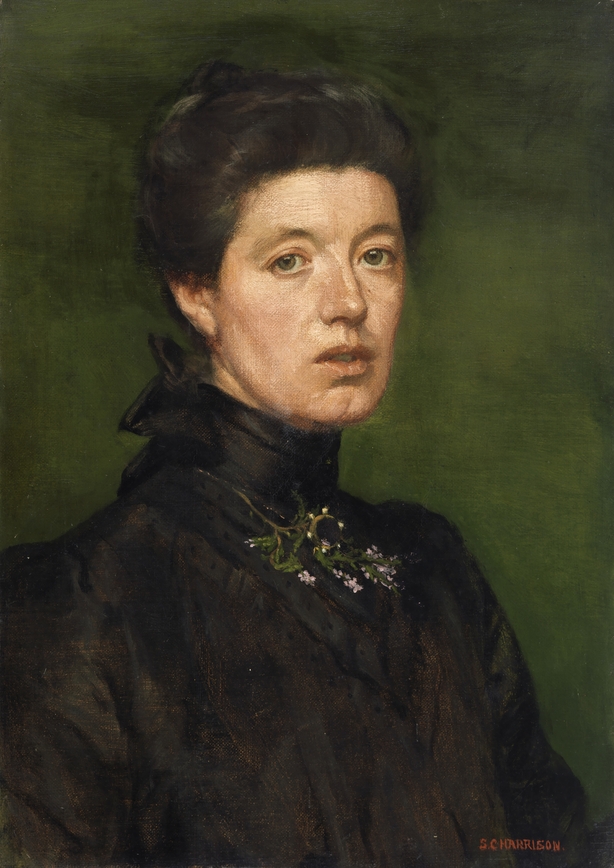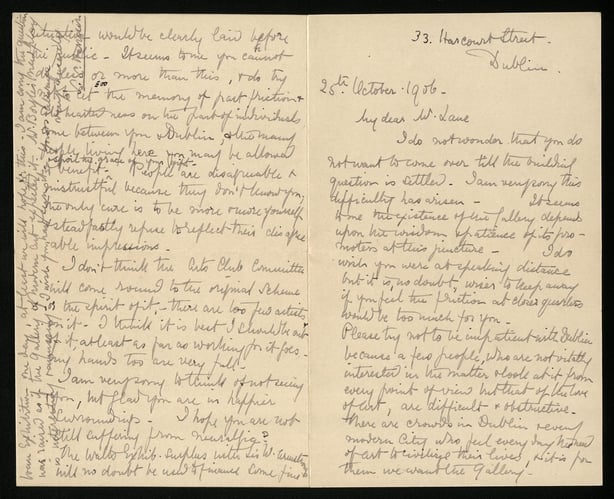Analysis: The Co. Down-born artist championed social reform projects to improve the lives of the city's poorest residents
By Hannah Baker, TCD
A record number of women candidates stood in the 2024 general election so it is fitting to remember a trailblazer in this regard; namely Dublin’s first female city councillor, Sarah Cecilia Harrison (1863-1941). A Co Down born woman from a wealthy, Church of Ireland background, Harrison was not your average city councillor. She had also spent 30 years living away from the island of Ireland, after she moved with her family to London at the age of ten. However, by 1904, she had relocated to Dublin and remained resident in the city for the rest of her life.
Harrison was also an artist and attended the Slade School of Fine Art in London, where she learnt a painting practice based on the tradition of the old masters, such as Andrea del Sarto. This traditional method was quite uncommon among artists of the period, particularly women, as they had been prohibited from accessing such a training until the latter half of the nineteenth-century. This period also coincided with the deconstruction of traditional academic education for both male and female artists as more avant-garde movements, which did not require such a rigorous training, grew in popularity.

Nevertheless, Harrison championed her schooling and developed a successful career as portrait painter, regularly exhibiting at such institutions as the Royal Hibernian Academy. Over her career she painted many members of Dublin’s cultural and political circles, including Hugh Lane, Sinn Fein Alderman Thomas Kelly, novelist George Moore, and suffrage supporters Anna and Thomas Haslam.
As soon as Harrison relocated to Dublin, and alongside her artistic career, she built a successful portfolio of social reform projects in order to improve the lives of its poorest residents. Harrison had a perfervid and practical work ethic, which was steered by powerful Christian principles. In politics, she worked tirelessly to ensure better access to employment, financial benefits, housing and food for the poorest residents of the city.
Her first role was Honorary Secretary to the Married Men’s Relief Fund. She also led the foundation of the Dublin City Labour Yard in 1906, to supply jobs to unemployed men, particularly those with families and became its Honorary Secretary. She founded and ran the Vacant Land Cultivation Society in 1909, which repurposed disused land in the city for allotments so that the city’s poorest residents could grow their own food.
We need your consent to load this rte-player contentWe use rte-player to manage extra content that can set cookies on your device and collect data about your activity. Please review their details and accept them to load the content.Manage Preferences
From RTÉ Radio 1, Dr Margarita Cappock on Sarah Cecilia Harrison
In 1912, Harrison made history by becoming the first female city councillor for Dublin. Armed with eight years of successful social reform projects, Harrison stood for election in the South City ward and was heralded by her supporters as being the voice of two underrepresented parties; women and the unemployed.
Despite being a constitutional nationalist and a supporter of the Irish Parliamentary Party and Home Rule, Harrison stood as an independent and won cross-party support from representatives of all areas of Irish society. For example, unionist supporter Anna Haslam, Sinn Féin Vice President Jennie Wyse Power and Catholic Priest Reverend L.J. Stafford.
Once elected, Harrison took her role very seriously and attended far more meetings than the average city councillor. She also publicised information regarding the running of the municipal council so as to bring the general public further into political life. Largely this meant highlighting areas of potential corruption in order to remedy them and promote integrity. Indeed, her supporters praised Harrison on 'her persistent habit of throwing light into dark corners of municipal administration.’

Letter from Sarah Cecilia Harrison to Hugh Lane discussing the Municipal Gallery meeting and funding on 25 October 1906. Photo: Hugh Lane Gallery
Within the council, Harrison served on committees responsible for Markets and Old Age Pensions, then from 1913; Paving and Housing. Additionally, she was well place to lobby the Council for a permanent gallery site for the Municipal Gallery of Art project, which was spearheaded by Harrison's close friend Hugh Lane and she herself had taken on most of the project's administration from 1905.
While the beginning of Harrison’s career as a councillor looked promising, her drive to publicly discredit specific committees and even individual councillors meant that she quickly became unpopular within the organisation. This continued throughout her three-year term in office and affected her efficacy in other areas. Her unpopularity with certain councillors led to a conscious effort to unseat her at the end of her three-year term. This effort was successful and Harrison was not re-elected in 1915. She stood again in 1920, but was unsuccessful, marking the end of her municipal career.
While the beginning of Harrison's career as a councillor looked promising, her drive to publicly discredit committees and individual councillors meant she quickly became unpopular
Despite this, Harrison continued to work as an artist and on philanthropic projects, just as she had done prior to her three year term. She also campaigned on behalf of women’s suffrage groups and became the chairperson of the Women’s Civic Union in 1916. She was always an advocate for the city’s working classes and held private meetings at her home six mornings a week where she documented individual concerns in order to form letters to the Board of Assistance.
Today scholarship on Harrison is growing. Besides this author’s PhD thesis (2024), the book Sarah Cecilia Harrison: Artist, Social Campaigner and City Councillor (edited by Dr Margarita Cappock) was published in 2022. Additionally, thanks to the generous support of Harrison’s descendant Anne Chisholm and her family, there is now an annual essay prize in Harrison’s name, hosted by the National Gallery of Ireland. However, as a woman who was exceptional both as an artist and a political figure, there is scope for far more.
Follow RTÉ Brainstorm on WhatsApp and Instagram for more stories and updates
Dr Hannah Baker was a Research Ireland Government of Ireland Postgraduate Scholar in the Department of History of Art and Architecture at Trinity College Dublin.
The views expressed here are those of the author and do not represent or reflect the views of RTÉ
